Preili Museum of History and Applied Arts (Latvia), Grodno State Museum of the History of Religion (Belarus) and Panevezys Local Lore Museum (Lithuania) joint virtual exhibition – footwear.
Preili Museum of History and Applied Arts
Is there a corner on the earth where a human foot would never have stepped? In a thousand years, both the highest peaks and the deepest canyons and lowlands have been conquered. Would humanity be able to do it without the right shoes – from the most ordinary leather moccasins and postols to the iconic “Air Jordan”. Wherever you go, you will always have shoes on your feet – with your imprint and your story.
The collection of footwear in the collection of the Museum of History and Applied Art of Preili is relatively small, but it forms a comprehensive picture of what footwear did Preili inhabitants used during the 20th century walking city streets and dusty country roads.
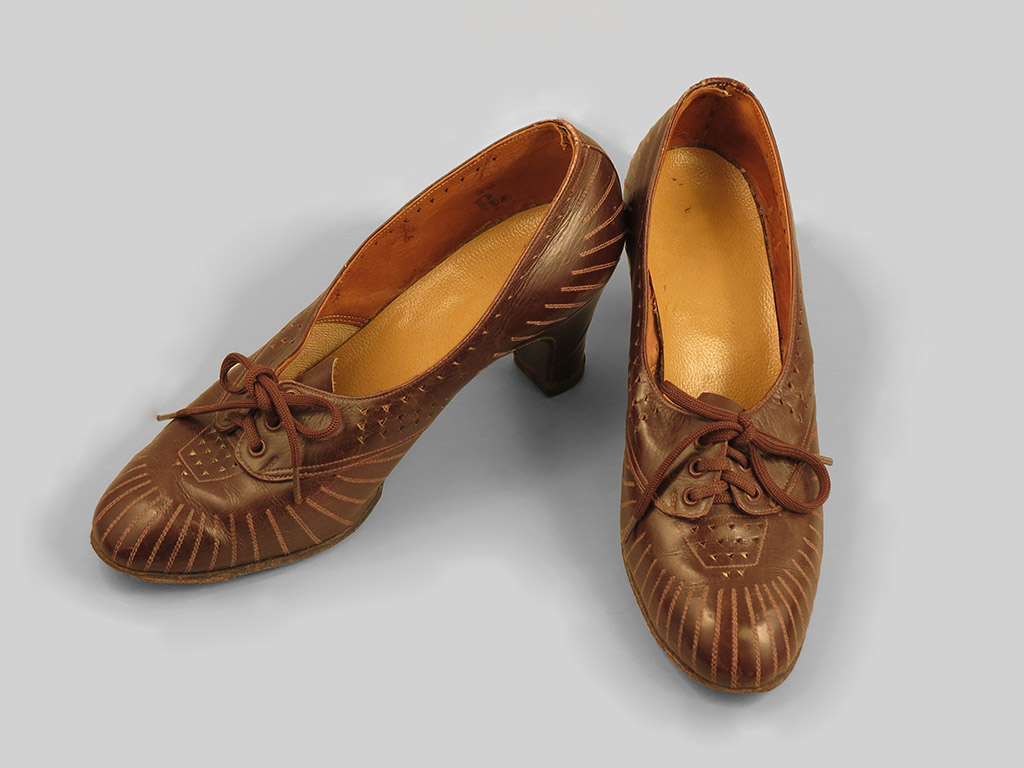
Leather shoes. 1930’s
Leather shoes owned by Jelikamida Ivanova are one of the finest shoes in the museum’s collection. The shoe has a high heel and decorative lacing on the upper. Every detail shows the fine handiwork of the employees of “D. Mogilnikov shoe factory” working in Riga, which was undoubtedly promoted by the high-quality standard of the owner of the factory – David Mogilnikov, who won a golden medal for the quality of his products in Paris in 1927.
J.Ivanova lived in Preiļi, working all her life at Preiļi post office, but in her free time she actively participated in the public life of the city. It is not clear how J.Ivanova got these shoes, maybe her brother – the famous composer Jānis Ivanovs – gave them as a present to her. However, at the end of the 1940s, J.Ivanova gave her shoes to her roommate Matrjona Kotļerova, who could not continue to wear the shoes, because they were too small, but highly appreciated the quality of the gift keeping them.
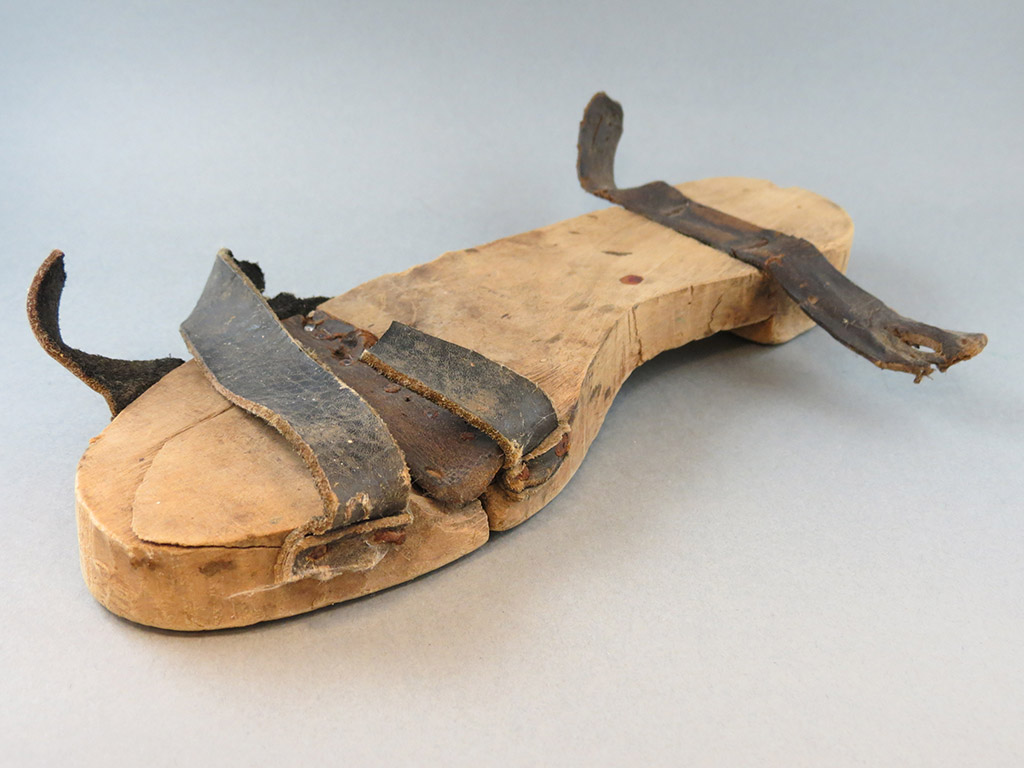
Wooden patten. 1940’s
Pattens, or shoes with a wooden sole, were called klikatiņas (probably due to their specific sound while walking). Made during World War II, belonged to Valentīna Dzene, who lived in Dzeni, Preili Parish.
Due to the shortage of footwear, klikatiņas became widely used by women during the wartime, also called ” frugality shoes”. Such shoes were widely popularized in the press during the German occupation. For example, on March 15, 1942, the newspaper “Darbs un Zeme” published an explanation why women have to wear such shoes, as well as samples of the patten shoes used in Germany with drawings and manufacturing instructions. The pattens were made of wooden soles and leather ties. To make the sole bend, it was sawed in two parts, joining the parts together with a strip of leather. Fabric or garters could also be used instead of leather.
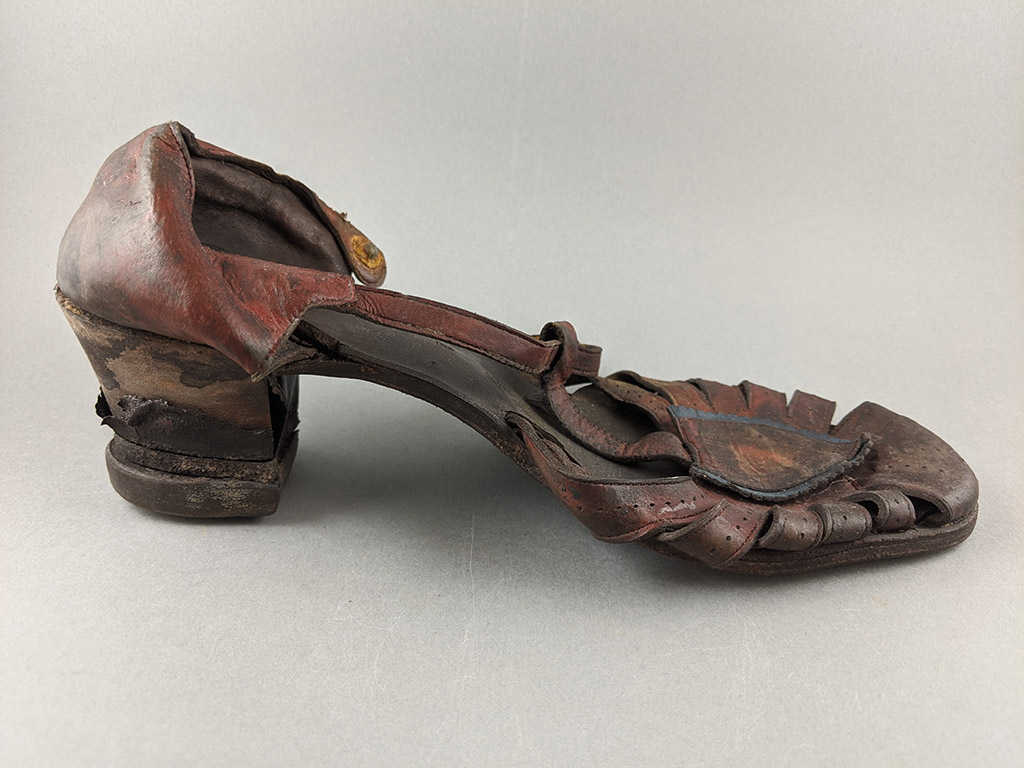
Leather shoe. 1930’s – the beginning of 1940’s
On November 2-16, 2018, several control excavations were carried out near the Preiļi Jewish Citizens’ Cemetery at the site where in the summer of 1941 Jews of Preiļi and the surrounding area were killed. The purpose of the control excavations was to find out the boundaries of the shooting site for the later improvement of the territory and the creation of a memorial. During the works, the boundaries of one mass grave was located and also very valuable items were obtained – the shoes of the Preili inhabitants killed during the Holocaust.
In the summer of 1944, German troops retreated throughout the territory of Latvia, trying to hide their crimes by burning the bodies of those killed. The same happened in Preili. The 20 shoes found were on the edge of a mass grave untouched by fire.
This red women’s sandal, with a high heel and a decorative “leaf” on the toe, is not only a testament to what shoes were used in Preili in the early 1940s before the German occupation, but also a unique testimony of the Holocaust in Preili and all over In Latvia.
Hrodna State Museum of the History of Religion
Shoes are an important part of the dress. They protect the feet from cold, dirt, moisture and mechanical injury by sharp stones, thorns, and tree roots protruding above the soil surface.
The most ancient type of footwear on the territory of Belarus is bast shoes, woven from bass or bark. They were known to both the Slavs and the Balts for a long time. At least from the end of the 16th century, leather shoes, better known as postols or porshens (a kind of sandals strapped to the feet), could also be called bast shoes. In addition to bast shoes made of bass or bark and postols, footwear made of leather or linen with a wooden bottom, cloth, linen ropes and threads was also traditional in the Grodno region. It is interesting that bast shoes made of bass or bark, even when they were out of use could retain their ritual significance. In some villages, for example, it was believed that if the deceased was buried in leather shoes, then the animal from whose skin it was made would disturb the deceased in the next world demanding its skin back. During the wedding, the bride and groom were presented with sandals as a symbol of loyalty, so that the newlyweds were always a couple.
Unlike the rural population, town dwellers generally wore nothing more than leather shoes. Postols, which were widely used in the 9th-13th centuries, were gradually complemented by boots, half boots and shoes with low leather heels. This is not surprising, because, Grodno, for example, was a well-known center of currying, which is reflected even in the famous engraving of Zündt (Matthias Zündt, 1568). The medieval footwear found by archaeologists in Grodno is distinct in its laconic form and almost complete lack of decor in comparison with footwear from Minsk, Brest or Polotsk.

Postols (porshens). Belarus. The beginning of the 20th century. Leather, stitchwork
Postols, which were used in the Grodno region at the beginning of the twentieth century, differ from modern footwear as they do not have solid details (a shoe sole, a shoe back, and a heel). Initially, they were made, as a rule, without the use of special tools or shoe lasts from one piece of leather, the edges of which were bent. To fix the postol on the foot, through slots were made in the shoemaking upper, through which belt frills were pulled. More sophisticated postols were made of two pieces of leather, the outer one of which was cut through on the toe-cap. Leather straps or laces were woven into the slots, creating a lace pattern.
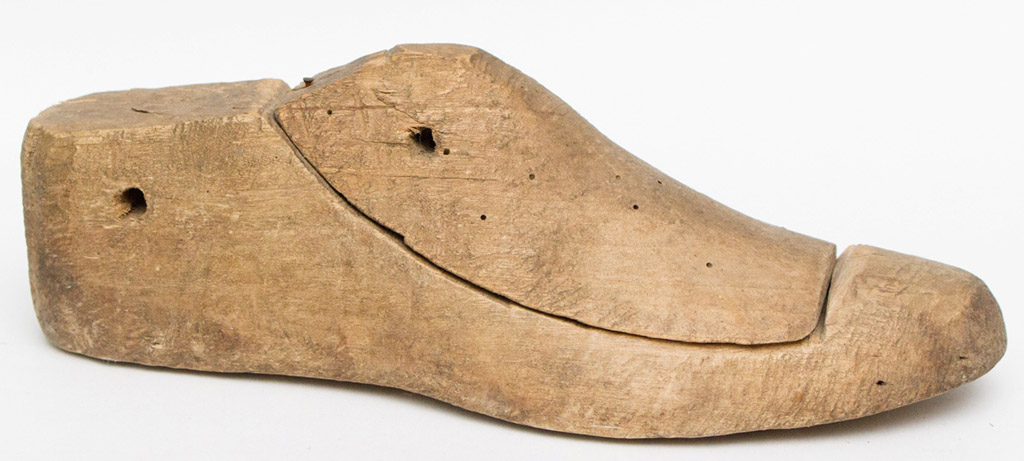
Shoe last. Craftsman Mikanovich Ivan Petrovich. Village Minyutevka of Schuchyn region. 1925-1927
Shoe last (Belarusian equivalent «kapyl») is a piece of wood in the shape of foot. Traditionally, the shoemaker uses it to make the shoes.
Although shoe lasts were found during archaeological excavations of ancient Polotsk, Minsk, Brest in the layers of the 11th – 13th centuries, they remained an attribute of urban artisans for a long time and were almost never used in villages. However, gradually the professional level of rural craftsmen grew, and they began to use more and more sophisticated materials and tools. Therefore, by the beginning of the 20th century even in the production of primitive shoes from bast or hemp ropes, shoe lasts were widely used. As a rule, they were made from birch or alder with nails battered in them.
Initially, the shoe lasts were entirely hand made specifically for each pair of shoes. Shoe lasts of different shoemakers differed from each other. This is why, the phraseological unit “to make something using your own kapyl”, meaning “to do something in your own way”, has been preserved in the Belarusian language till now.
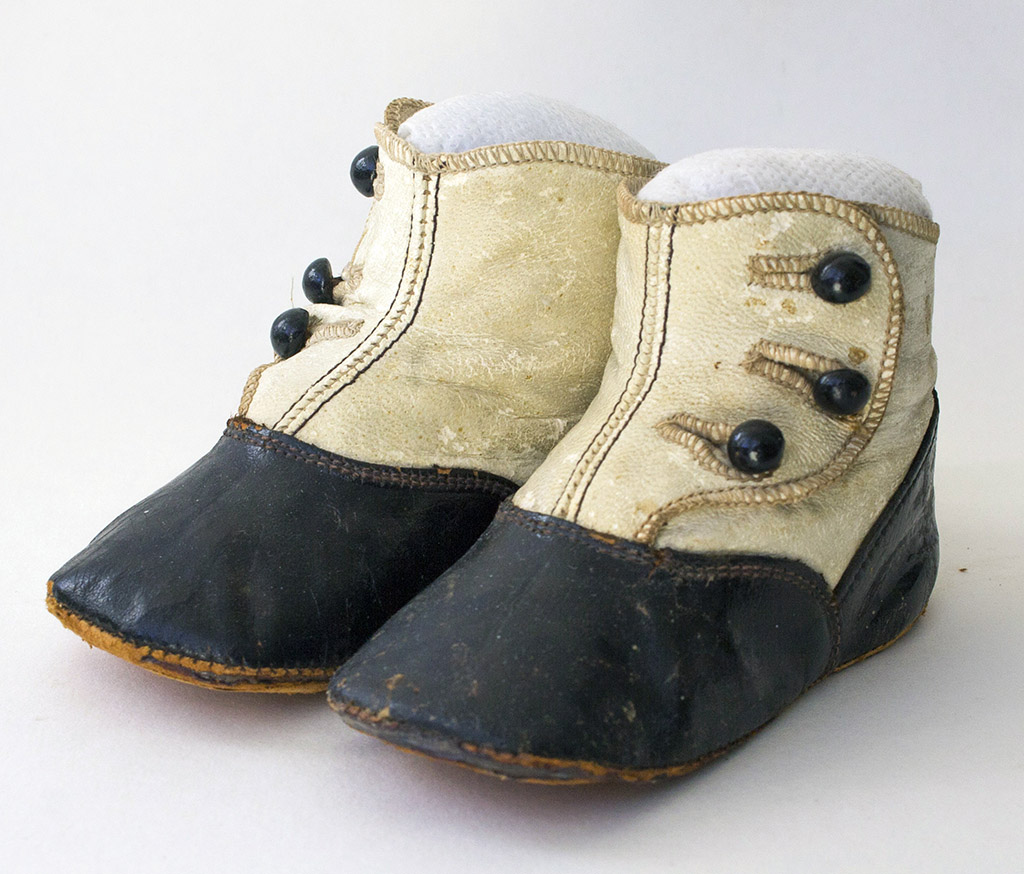
Children’s shoes (“pinetki” or baby-shoes). France. The end of the 19th century. Leather, bone, stichwork
Until the middle of the 19th century, shoes for babies were not practically thought of. Babies were swaddled tightly, and there was no need to make special shoes for them. Miniature shoes began to spread after 1860, when French craftsman François Pinet began making children’s shoes. By that time, Pinet was already known in Paris as a fashionable manufacturer of women’s shoes. His popularity was growing rapidly; moreover, he became one of the first to put designer brands on his products. Pinet, as well as Charles Worth, is considered to be the creator of the haute couture phenomenon. His shoes belonged to the elite ones, but found their connoisseurs abroad, including in the Russian Empire. Pinet’s children’s shoes were also actively supplied there. So, soon the products of other masters, similar to his shoes, began to be called “pinetki”.
The first Pinet’s children’s shoes were soft shoes without a rigid sole, which were fixed to the foot with a button. The presented pair is a more late closed variation with three buttons designed to be worn in cool weather.
Panevėžys Local Lore Museum
The primary purpose of footwear is to protect feet from external influences. At the same time, they are museum relics of various periods, reflecting the fashions of the epochs, cultural traditions and economic situation. Footwear can describe a person’s wealth, place of residence, social class or even occupation. Proverbs and sayings found in Lithuanian folklore testify that the person himself was described according to his shoes.
Examples of footwear from different periods are stored in the funds of Panevėžys Local Lore Museum: women’s, men’s, children’s shoes, handmade, shoemaker-made and factory-made footwear. There are lots of collected footwear worn by peasants: bast-shoes, carbatinae, klomps, clogs, knitted slippers. The oldest of them are of the end of 19th century. Exclusive examples of footwear are shoes of Panevėžys Drama Theater performance characters.

Women’s bast-shoes. 3rd-4th decades of the 20th century. Photo of G. Kartanas.
Bast-shoes are a traditional handmade shoes made from the inside of trees (usually linden, osier or willow) bark strips, called bast. These bast-shoes are braided diagonally two-heddled of 2 m length and 2 cm wide linden bast. Loops are installed on the sides for bast-shoe string (not remained). Bast-shoe string are strips of linen, hemp or leather, that are wrapped around the leg and used for holding the footwrap. Before putting the bast-shoes on, men wrapped their legs with footwraps, women wore socks. Soles were braid thicker, sometimes hemmed by leather. Bast-shoes were worn all year round. Winter bast-shoes were longer and wider, the inside of them were warmed with rough cloth or leather. Bast-shoes were mostly braid by men on winter evenings. They were worn for the longest time in Aukštaitija and Dzūkija regions – even until the middle of the 20th century.
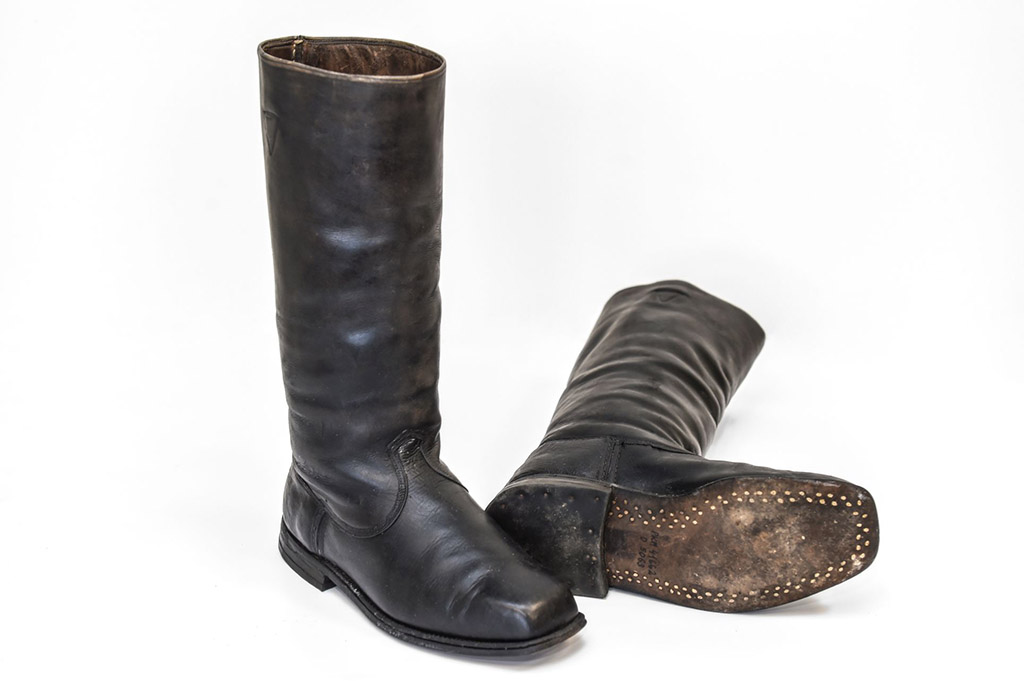
Men’s high-topped leather boots. Mid of 20th century. Photo of G. Kartanas.
It was handmade shoes made by shoemaker. The sole reinforced with wooden nails. In the interwar period, such shoes were worn by farmers, craftsmen, in the postwar period they were worn by Lithuanian partisans. This pair of shoes are exhibited in the Panevėžys Local Lore Museum Exhibition of the Resistance to the Soviet Occupation and the Sąjūdis Movement.
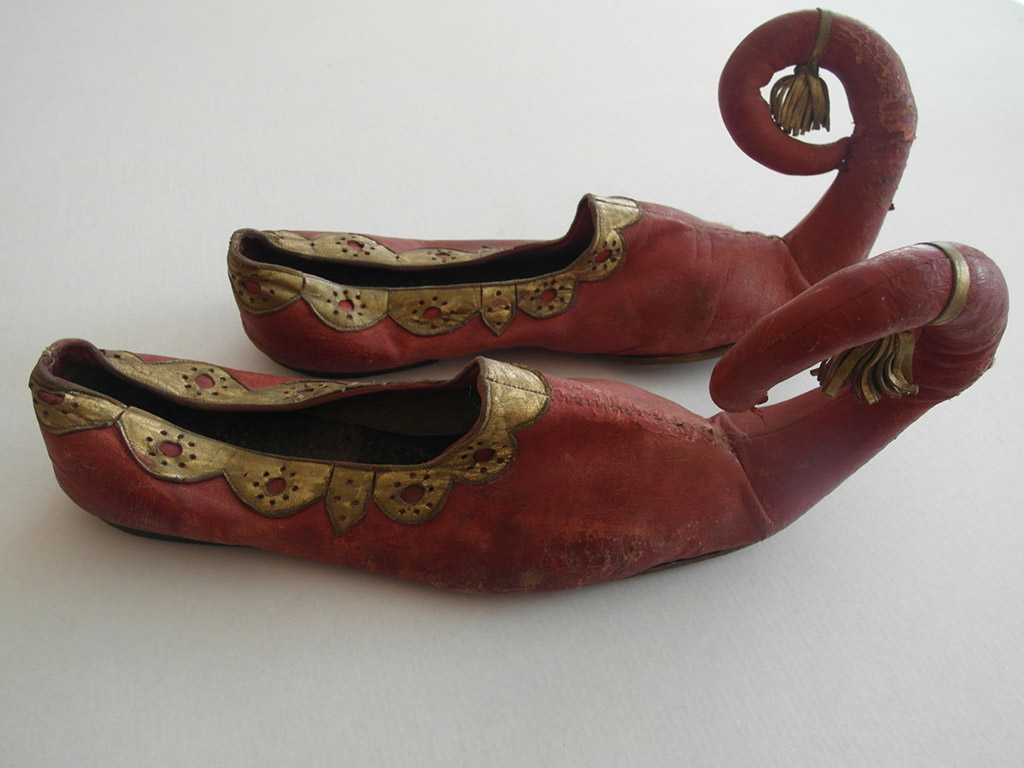
Shoes of the character The Sharphead of Panevėžys Drama Theater performance “About those who love”.
The performance was staged in 1955 by director Jonas Alekna, based on a play by Aleksandras Antokolskis. The role of The Sharphead was performed by actor Bronius Babkauskas.
About the project ENI-LLB-1-244 “Promotion of historical and culture cross border through museums innovations” / Museum 2020
The project aims to build a cross border cooperation platform creating preconditions for ensuring the increasing interest of tourists and visitors about the cultural and historical heritage in the border area of Latvia, Lithuania and Belarus.
This project is funded by the European Union
Project budget: 367 864.64 EUR, EU funding 331 078.17 EUR
Project implementation period: 1st of June 2020 – 31st of May 2022
European Neighbourhood Instrument Cross-border Cooperation Programme Latvia-LithuaniaBelarus 2014-2020
